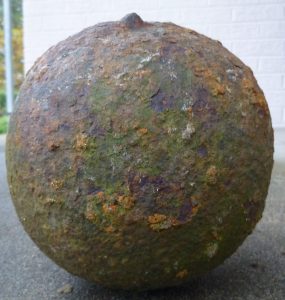What was it like to fire thirty-two pound cannonballs in the early years of the Volunteer Artillery? We have an eye witness from 1864.
Wanderer was his pen name and he wrote for a London periodical called The Sporting Review. He was staying in Lochgilphead during his grand tour of western Scotland, when he came across a military competition about to take place on the beach. This was the first ever shooting competition of Argyll’s Volunteer Artillery.
Plenty of spectators had gathered at the northern tip of Loch Gilp on that wet and windy Tuesday. Below them on the beach, 32-pounder smooth-bore cannon were deployed. These were ships’ cannon, old, no longer needed by the Royal Navy, now issued to the Volunteer Artillery for coastal defence. The guns pointed across a huge expanse of mud to the sea beyond. Thirteen hundred yards away, moored to a raft and anchored to the sea bed, the target rose and dipped with the tide. It was just eight feet by ten feet.
Ten detachments stood next to the guns. They had come from remote corners of Argyll: two detachments from tiny Easdale and others from the Isles of Mull, Islay and Bute, and from the peninsulas of Kintyre and Cowal.
Wanderer observed the shooting carefully. “It was curious to watch the ricochet shots,” he wrote, “which produced a very fine effect as the balls bounced along Loch Gilp to an immense distance beyond the target, making a heavy thug at each time of striking the water, which they threw up to a considerable height in the air, while smacks and open boats cruised about, apparently unheeding their near approach to the line of shot.”
At the end of the day there was a clear winner of the £5 prize: the detachment from South Hall on Cowal. There was no prize for Easdale but the men would not have been too dejected. Of sixty cannonballs fired that day, only seven were direct hits, and the Easdale men had scored one of them.
These old naval guns, at their best in the close quarter mayhem of sea battles, were less accurate over large distances.  When they fired, much of the propellant’s force rushed past the projectile and escaped, an effect known as windage, leaving the cannonball to rattle its way up the barrel in pursuit. Because of windage, cannonballs could fly at odd speeds and odd angles and often ricochet off the surface of the sea.
When they fired, much of the propellant’s force rushed past the projectile and escaped, an effect known as windage, leaving the cannonball to rattle its way up the barrel in pursuit. Because of windage, cannonballs could fly at odd speeds and odd angles and often ricochet off the surface of the sea.
More worrying is Wanderer’s account of small boats cruising so close to the line of shot. Range safety was always taken seriously. We have no reason to doubt the conduct of the umpire, Captain Kettle, or of the Range Party under Lieutenant Angus Whyte. But it seems that the good people of Lochgilphead chose blindly to ignore it.
Above – a 32-pdr cannonball which has survived on Seil for a century and a half.
Top photo – the artillery badge on the leather pouch of a crossbelt, once worn by the Easdale Volunteers
